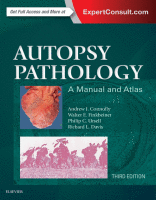Physical Address
304 North Cardinal St.
Dorchester Center, MA 02124

Brightfield Microscopy Brightfield or light microscopic analysis of organs and tissues supplements the gross autopsy examination and is an integral part of a complete postmortem examination. Although the focus and extent of the microscopic examination vary from case to case,…

Autopsy Photography The benefits of autopsy photographs have increased greatly with digital photography, and gross photographs can be important parts of autopsy reports, clinical conferences, consultation, teaching, and research. Digital cameras are quite easy to use and, with a moderate…

The thorough standard postmortem examination (described in Chapters 4 and 5 ) provides the framework for accurately detecting and diagnosing most clinical disease. However, the skillful autopsy pathologist, recognizing the limitations of the basic examination, supplements it with special dissections…

The autopsy of the fetus, infant, or young child should be approached somewhat differently from that of the adult. At these early developmental stages, the presence of malformations is often the major consideration, and the dissection should be made to…

This chapter describes and illustrates systematic dissection sequences and procedures. Although developing a systematic approach to autopsy dissection and organ examination is efficient and generally desirable, the pathologist must be prepared to alter the examination as required for the best…

During the course of work, the autopsy pathologist and staff members encounter a number of potential biohazards. By adhering to strict safety precautions, practicing proper autopsy technique, and using proper instruments and equipment, the pathologist can limit the risk of…

Autopsy Authorization The laws pertaining to authorization for autopsy vary among the states. Local jurisdictions may establish policies or procedures for compliance, and it behooves the practicing pathologist to know the relevant statutes in his or her region. In the…

The quotation above (Latin for “the dead teach the living”) historically has been cited either literally, as justification for examination of cadavers to learn anatomy and investigate pathology, or figuratively, to indicate learning from the work of past scholars. This…